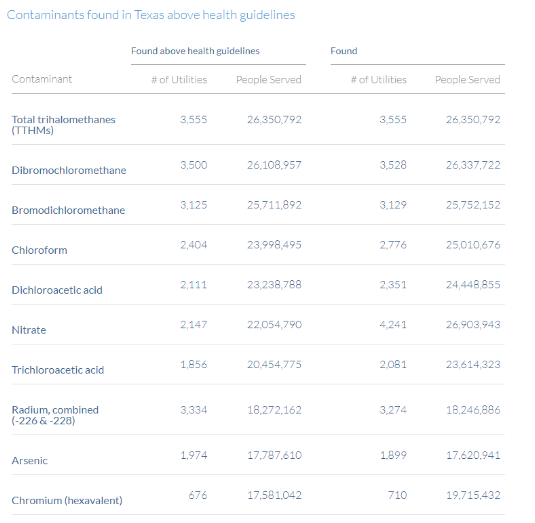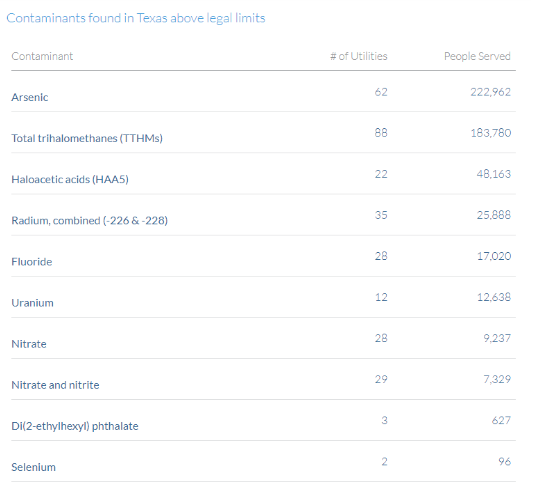Home › Blog › Polluted water — how will Texas solve its water quality crisis?

In October 2019, the non-profit Environmental Working Group (EWG), in cooperation with independent scientists, published the results of its study comprising about 50,000 local water utilities in all 50 states.
For instance, the report concluded that Dallas’ water supply had 37 contaminants, 10 of which exceeded the health guidelines recommended by EWG during the test period between 2012 and 2017. The Dallas Water Utility is cited in the report as serving 1,197,816 people.
The Environmental Working Group works with independant scientists to test the water quality in about 50,000 local water utilities in all 50 states.
EPA Legal Limits of Contaminates are Outdated
The most publicized issues regarding Texas’ water quality in recent years are the high levels of arsenic, lead and radiation, as well as chemicals with names too difficult to pronounce.
An article in the Dallas Patch (1) notes, “The substances are linked to cancer, damage to the brain and nervous system, hormonal disruption, problems in pregnancy and other serious health conditions.” Supporting these claims, the article lists the contaminants, their potential dangers, the rate the contaminants appear, the EWG recommended rates and the rates at which the contaminants exceed the guidelines.
The legal limits are also listed, but the reporter quotes a science analyst at EWG saying that the legal guidelines are seriously outdated and the EPA has not taken the needed steps to reduce them, based on current scientific findings. These are the Environmental Working Group’s statistics on the quality of Tap Water throughout the State of Texas (2).


EPA Awards $1.2 Million to Fund Texas Water Pollution Control Programs
In mid-January 2020, the U.S. Environmental Protection Agency (EPA) announced it had awarded $1.2 million to the Texas Commission on Environmental Quality (TCEQ) earmarked for water pollution control programs. (3,4)
This funding is intended to help safeguard all water quality, including that of rivers, lakes, streams, groundwater and other waterbodies. In addition, it will be used for “monitoring water quality, developing and implementing water quality standards, and monitoring groundwater.”
Unfortunately, the problems in Texas are as big as the state: The waters in small and remote communities are often the most polluted, in part because the infrastructure is deteriorating, monitoring is not frequent enough, there is insufficient funding and there are even shortages of trained staff to monitor the water — shortages that are expected to grow as experts retire.
TIP: Learn more about the water quality where you live and in remote areas of your state. Visit the EWG Tap Water Data Base — 2019 Update for Texas (if you are not from Texas, click here). Remember, we are all in this together!
For more information about Watergen’s technology, Visit our website and follow us on Facebook!
[1] https://patch.com/texas/dallas-ftworth/cancer-linked-contaminants-found-dallas-drinking-water-study
[2] https://www.ewg.org/tapwater/state.php?stab=TX
[3]https://www.epa.gov/newsreleases/epa-grant-12m-will-support-water-pollution-control-texas
[4] https://www.waterworld.com/environmental/article/14074530/epa-grants-12m-for-water-pollution-control-in-texas